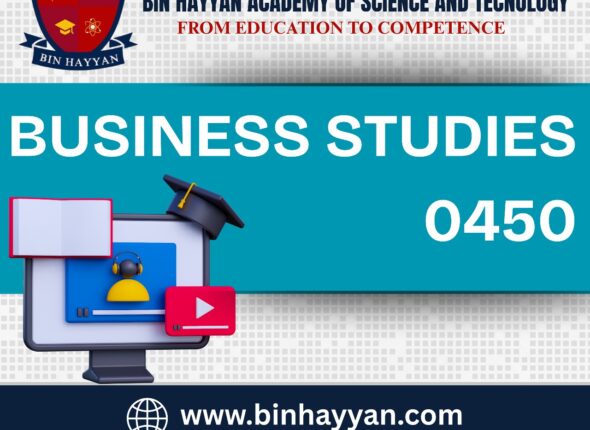No products in the cart.
Course Content
The fundamentals of accounting
-
understand and explain the difference between book-keeping and accounting
-
state the purposes of measuring business profit and loss
-
explain the role of accounting in providing information for monitoring progress and decision-making
-
explain the meaning of assets, liabilities and owner’s equity
-
explain and apply the accounting equation.
Sources and recording of data
-
outline the double entry system of book-keeping
-
process accounting data using the double entry system
-
prepare ledger accounts
-
post transactions to the ledger accounts
-
balance ledger accounts as required and make transfers to financial statements
-
interpret ledger accounts and their balances
-
recognise the division of the ledger into the sales ledger, the purchases ledger and the nominal (general) ledger.
-
recognise and understand the following business documents: invoice, debit note, credit note, statement of account, cheque, receipt
-
complete pro-forma business documents
-
understand the use of business documents as sources of information: invoice, credit note, cheque counterfoil, paying-in slip, receipt, bank statement.
-
explain the advantage of using various books of prime entry
-
explain the use of and process accounting data in the books of prime entry: cash book, petty cash book, sales journal, purchases journal, sales returns journal, purchases returns journal and the general journal
-
post the ledger entries from the books of prime entry
-
distinguish between and account for trade discount and cash discounts
-
explain the dual function of the cash book as a book of prime entry and as a ledger account for bank and cash
-
explain the use of and record payments and receipts made by bank transfers and other electronic means
-
explain and apply the imprest system of petty cash.
Verification of accounting records
-
understand that a trial balance is a statement of ledger balances on a particular date
-
outline the uses and limitations of a trial balance
-
prepare a trial balance from a given list of balances and amend a trial balance which contains errors
-
identify and explain those errors which do not affect the trial balance: commission, compensating, complete reversal, omission, original entry, principle
-
correct errors by means of journal entries
-
explain the use of a suspense account as a temporary measure to balance the trial balance
-
correct errors by means of suspense accounts
-
adjust a profit or loss for an accounting period after the correction of errors • understand the effect of correction of errors on a statement of financial position
-
understand the use and purpose of a bank statement
-
update the cash book for bank charges, bank interest paid and received, correction of errors, credit transfers, direct debits, dividends, and standing orders
-
understand the purpose of and prepare a bank reconciliation statement to include bank errors, uncredited deposits and unpresented cheques.
-
understand the purposes of purchases ledger and sales ledger control accounts
-
identify the books of prime entry as sources of information for the control account entries
-
prepare purchases ledger and sales ledger control accounts to include credit purchases and sales, receipts and payments, cash discounts, returns, irrecoverable debts, dishonoured cheques, interest on overdue accounts.
Accounting procedures
-
distinguish between and account for capital expenditure and revenue expenditure
-
distinguish between and account for capital receipts and revenue receipts
-
calculate and comment on the effect on profit of incorrect treatment
-
calculate and comment on the effect on asset valuations of incorrect treatment.
-
define depreciation
-
explain the reasons for accounting for depreciation
-
name and describe the straight-line, reducing balance and revaluation methods of depreciation
-
prepare ledger accounts and journal entries for the provision of depreciation
-
prepare ledger accounts and journal entries to record the sale of non-current assets, including the use of disposal accounts.
-
recognise the importance of matching costs and revenues
-
prepare ledger accounts and journal entries to record accrued and prepaid expenses
-
prepare ledger accounts and journal entries to record accrued and prepaid incomes.
-
understand the meaning of irrecoverable debts and recovery of debts written of
-
prepare ledger accounts and journal entries to record irrecoverable debts
-
prepare ledger accounts and journal entries to record recovery of debts written of
-
explain the reasons for maintaining a provision for doubtful debt
-
prepare ledger accounts and journal entries to record the creation of, and adjustments to, a provision for doubtful debts
-
understand the basis of the valuation of inventory at the lower of cost and net realisable value
-
prepare simple inventory valuation statements • recognise the importance of valuation of inventory and the effect of an incorrect valuation of inventory on gross profit, profit for the year, equity and asset valuation.
Preparation of financial statements
-
explain the advantages and disadvantages of operating as a sole trader
-
explain the importance of preparing income statements and statements of financial position
-
explain the difference between a trading business and a service business
-
prepare income statements for trading businesses and for service businesses
-
understand that statements of financial position record assets and liabilities on a specified date
-
recognise and define the content of a statement of financial position: non-current assets, intangible assets, current assets, current liabilities, non-current liabilities and capita
-
understand the inter-relationship of items in a statement of financial position
-
prepare statements of financial position for trading businesses and service businesses
-
make adjustments for provision for depreciation using the straight line, reducing balance and revaluation methods
-
make adjustments for accrued and prepaid expenses and accrued and prepaid income
-
make adjustments for irrecoverable debts and provisions for doubtful debts
-
make adjustments for goods taken by the owner for own use.
-
explain the advantages and disadvantages of forming a partnership
-
outline the importance and contents of a partnership agreement
-
explain the purpose of an appropriation account
-
prepare income statements, appropriation accounts and statements of financial position
-
record interest on partners’ loans, interest on capital, interest on drawings, partners’ salaries and the division of the balance of profit or loss
-
make adjustments to financial statements as detailed in 5.1 (sole traders)
-
explain the uses of and differences between capital and current accounts
-
draw up partners’ capital and current accounts in ledger account form and as part of a statement of financial position.
-
explain the advantages and disadvantages of operating as a limited company
-
understand the meaning of the term limited liability
-
understand the meaning of the term equity
-
understand the capital structure of a limited company comprising preference share capital, ordinary share capital, general reserve and retained earnings
-
understand and distinguish between issued, called-up and paid-up share capital
-
understand and distinguish between share capital (preference shares and ordinary shares) and loan capital (debentures)
-
prepare income statements, statements of changes in equity and statements of financial position . make adjustments to financial statements as detailed in 5.1 (sole traders).
-
distinguish between receipts and payments accounts and income and expenditure accounts
-
prepare receipts and payments accounts
-
prepare accounts for revenue-generating activities, e.g. refreshments, subscriptions
-
prepare income and expenditure accounts and statements of financial position
-
make adjustments to financial statements as detailed in 5.1 (sole traders)
-
define and calculate the accumulated fund.
-
understand direct material, direct labour, prime cost and factory overheads
-
understand and make adjustments for work in progress
-
calculate factory cost of production
-
prepare manufacturing accounts, income statements and statements of financial position
-
make adjustments to financial statements as detailed in 5.1 (sole traders).
-
explain the disadvantages of not maintaining a full set of accounting records
-
prepare opening and closing statements of affairs
-
calculate profit or loss for the year from changes in capital over time
-
calculate sales, purchases, gross profit, trade receivables and trade payables and other figures from incomplete information
-
prepare income statements and statements of financial position from incomplete records
-
make adjustments to financial statements as detailed in 5.1 (sole traders) . apply the techniques of mark-up, margin and inventory turnover to arrive at missing figures.
Analysis and interpretation
-
Candidates should be able to understand, calculate and explain the importance of the following accounting ratios:
-
Gross margin
-
Profit margin
-
Return on capital employed (ROCE) • Current ratio • Liquid (acid test) ratio • Rate of inventory turnover (times) • Trade receivables turnover (days) • Trade payables turnover (days)
-
prepare and comment on simple statements showing comparison of results for different years
-
make recommendations and suggestions for improving profitability and working capital
-
understand the significance of the difference between the gross margin and the profit margin as an indicator of a business’s efficiency
-
explain the relationship of gross profit and profit for the year to the valuation of inventory, rate of inventory turnover, revenue, expenses, and equity.
-
understand the problems of inter-firm comparison
-
apply accounting ratios to inter-firm comparison
-
Candidates should be able to explain the uses of accounting information by the following interested parties for decision-making:
-
owners
-
managers
-
trade payable
-
bank
-
investors
-
bank member
-
other interested parties such as governments, tax authorities, etc.
-
Candidates should be able to recognise the limitations of accounting statements due to such factors as:
-
historic cost • difficulties of definition • non-financial aspects
Accounting principles and policies
-
Candidates should be able to explain and recognise the application of the following accounting principles:
-
matching
-
business entity
-
consistency
-
duality
-
going concern
-
historic cost
-
materiality • money measurement
-
prudence
-
realisation
-
Candidates should be able to recognise the influence of international accounting standards and understand the following objectives in selecting accounting policies:
-
comparability • relevance • reliability • understandability
Student Ratings & Reviews

No Review Yet

Course Particulars
- Fee:Free
Lessons:131
- Level:Intermediate
- Last Updated:25/08/2025
Hi, Welcome back!
Similar Courses
All Levels
CHEMISTRY – 0971
(0.0/ 0 Rating)
$ 11 – $ 750Price range: $ 11 through $ 750
- 255 Lessons
- 0 Students
All Levels
CHEMISTRY – 0971
(0.0/ 0 Rating)
$ 11 – $ 750Price range: $ 11 through $ 750
Candidates study the following topics .These Topis are almost same for all these 3 courses.:States of matterAtoms, elements and compoundsStoichiometryElectrochemistryChemical energeticsChemical reactionsAcids, bases and saltsThe...
- 255 Lessons
- 0 Students
All Levels
BUSINESS STUDIES – 0450
(0.0/ 0 Rating)
$ 11 – $ 750Price range: $ 11 through $ 750
- 72 Lessons
- 0 Students
All Levels
BUSINESS STUDIES – 0450
(0.0/ 0 Rating)
$ 11 – $ 750Price range: $ 11 through $ 750
Content overview1 Understanding business activityThis section introduces the underlying ideas and concepts of business and includes the purpose and nature ofbusiness activity and how businesses can...
- 72 Lessons
- 0 Students
All Levels
BIOLOGY – 610
(0.0/ 0 Rating)
$ 11 – $ 750Price range: $ 11 through $ 750
- 415 Lessons
- 0 Students
All Levels
BIOLOGY – 610
(0.0/ 0 Rating)
$ 11 – $ 750Price range: $ 11 through $ 750
Candidates study the following topics:1 Characteristics and classification of living organisms2 Organisation of the organism3 Movement into and out of cells4 Biological molecules5 Enzymes6 Plant...
- 415 Lessons
- 0 Students
All Levels
BIOLOGY – 0970
(0.0/ 0 Rating)
$ 11 – $ 750Price range: $ 11 through $ 750
- 411 Lessons
- 2 Students
All Levels
BIOLOGY – 0970
(0.0/ 0 Rating)
$ 11 – $ 750Price range: $ 11 through $ 750
Candidates study the following topics:1 Characteristics and classification of living organisms2 Organisation of the organism3 Movement into and out of cells4 Biological molecules5 Enzymes6 Plant...
- 411 Lessons
- 2 Students
All Levels
PHYSICS – 0972
(0.0/ 0 Rating)
$ 11 – $ 750Price range: $ 11 through $ 750
- 331 Lessons
- 0 Students
All Levels
PHYSICS – 0972
(0.0/ 0 Rating)
$ 11 – $ 750Price range: $ 11 through $ 750
Candidates study the following topics:1 Motion, forces and energy2 Thermal physics3 Waves4 Electricity and magnetism5 Nuclear physics6 Space physics
- 331 Lessons
- 0 Students
Intermediate
Environment management 0680
(0.0/ 0 Rating)
Free
Rocks and minerals and their exploitation2 Energy and the environment3 Agriculture and the environment4 Water and its management5 Oceans and fisheries6 Managing natural hazards7 The...
- 87 Lessons
- 0 Students
Intermediate
Physics-0625
(0.0/ 0 Rating)
Free
Candidates study the following topics:1 Motion, forces and energy2 Thermal physics3 Waves4 Electricity and magnetism5 Nuclear physics6 Space physics
- 339 Lessons
- 0 Students
Intermediate
Sciences-0973
(0.0/ 0 Rating)
Free
Candidates must study all three sections.BiologyB1 Characteristics of living organismsB2 CellsB3 Movement into and out of cellsB4 Biological moleculesB5 EnzymesB6 Plant nutritionB7 Human nutritionB8 Transport...
- 696 Lessons
- 0 Students
Intermediate
Physics-5054
(0.0/ 0 Rating)
Free
Candidates study the following topics:1 Motion, forces and energy2 Thermal physics3 Waves4 Electricity and magnetism5 Nuclear physics6 Space physics
- 292 Lessons
- 0 Students
Intermediate
Sciences-0654
(0.0/ 0 Rating)
Free
Candidates must study all three sections.BiologyB1 Characteristics of living organismsB2 CellsB3 Movement into and out of cellsB4 Biological moleculesB5 EnzymesB6 Plant nutritionB7 Human nutritionB8 Transport...
- 696 Lessons
- 0 Students
All Levels
GCSE/IGCSE/O-levels
(0.0/ 0 Rating)
Free
📚 GCSE (General Certificate of Secondary Education)The GCSE is the standard secondary school qualification in the United Kingdom. It is widely recognized by universities and...
- 0 Lessons
- 0 Students
All Levels
Past Papers GCSE / IGCSE / O Level
(0.0/ 0 Rating)
Free
📚 GCSE / IGCSE / O Level Past Papers – DescriptionUnlock success with our comprehensive collection of past papers for GCSE, IGCSE, and O Level...
- 2 Lessons
- 0 Students
All Levels
Mathematics – 0580
(0.0/ 0 Rating)
Free
Students study the following topics 1. Number2. Algebra and graphs3. Coordinate geometry4. Geometry5. Mensuration6. Trigonometry7. Transformations and vectors8. Probability9. Statistics
- 155 Lessons
- 0 Students













